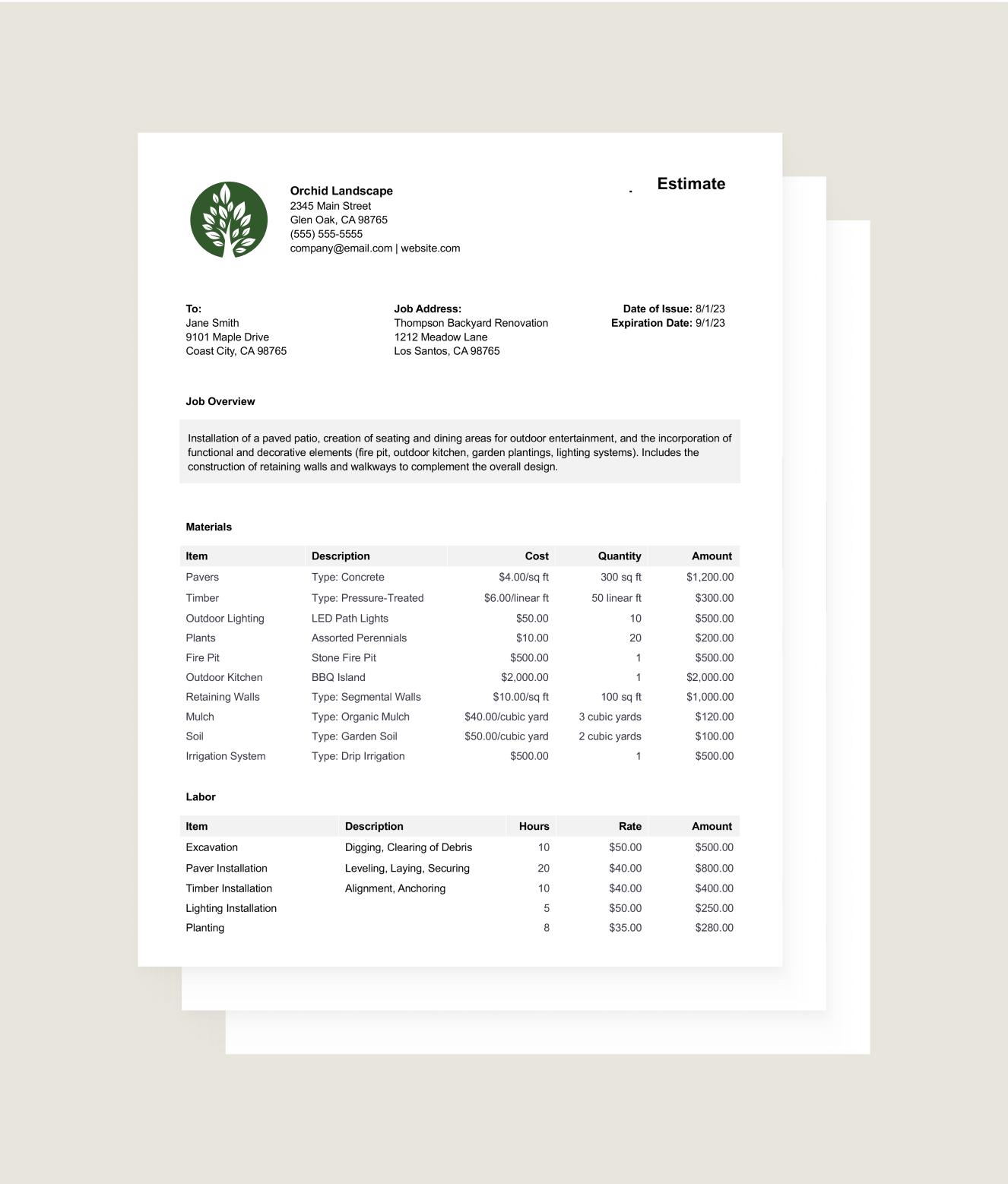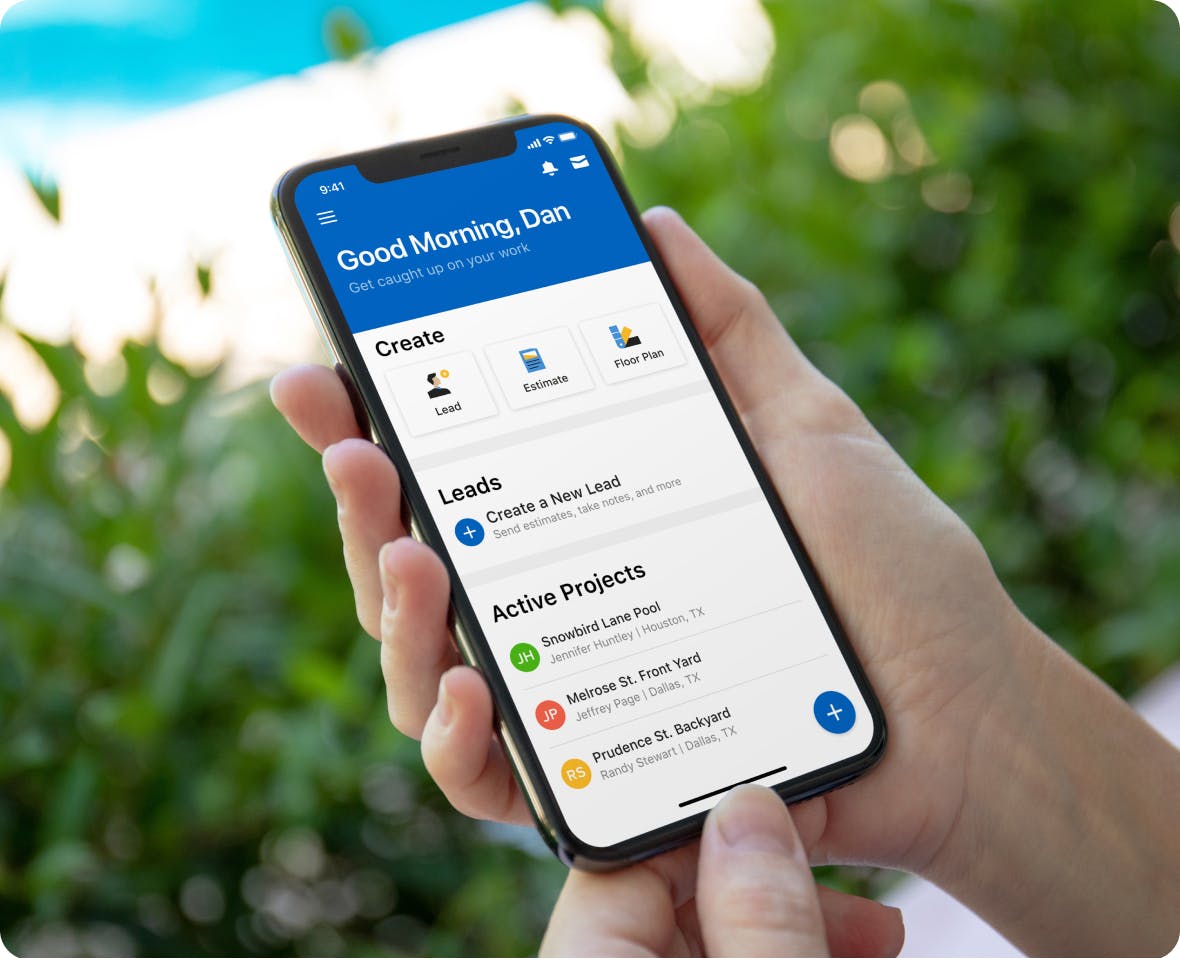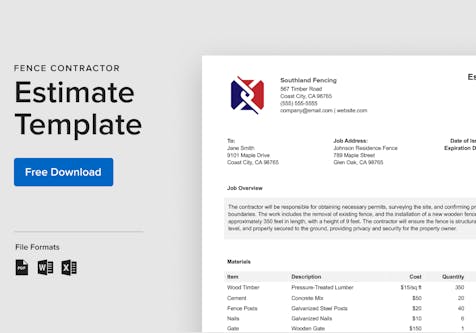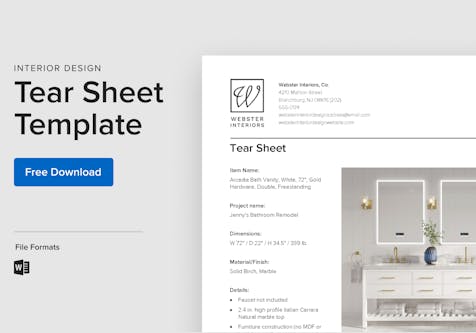Free Template: How to do a Landscaping Estimate
Unearth the power of precision with our landscaping estimate template. Learn how to create one, then check out our landscaping cost estimate sample to get started today.

Getting project estimates right in your landscaping business is part art, and part science. In this article, we offer tips and tools for creating accurate, professional-looking estimates more quickly and easily. We also include a free, downloadable template that you can edit and customize to meet your needs.
Read on to learn the makings of a professional landscaping estimate, why they are crucial to running a successful landscape business, which details to include, where they fall within the landscape construction lifecycle and more.
Don’t need every detail in this article? Click on a link below to jump to the section you are most interested in:
- Download our free landscape estimate template
- What is a landscape estimate?
- Why are landscaping cost estimates important?
- When do you send a landscape estimate?
- What should be included in a landscape cost estimate?
- Optional sections to include in a landscaping estimate template
- How to create a landscape estimate step-by-step
- Alternatives to landscape estimate templates
- Final landscape estimating tips
Download our Free, Printable Landscaping Estimate Template

Here's a Landscape Estimate Template on Us!
Customize this Landscape Estimate Template to secure your next job.
With so many details to attend to even before you win your first client, starting your own landscaping contractor business is no easy task. Learning the skill of estimating is likely near the top of your list of must-dos. We are here to get you started with an estimate template.
Our free landscaping estimate template is available in both Word, Excel, and PDF, and includes a completed landscaping estimate example to get you inspired to create your own. The landscaping estimate sheet is downloadable so you can print it, email it and share it with clients. It is also easy to edit so anyone can tailor the template to the needs of their landscaping firm.

Templates are a great way to help you get started with estimates, but in the long run many landscaping professionals graduate to using landscape estimate software because they find it helps them run their growing businesses more competitively.

Using all-in-one management software like Houzz Pro lets you create accurate and thorough estimates more quickly, puts at your fingertips the latest high-tech tools such as 3D and AI to bring your design vision to life for clients, and helps landscape pros create professional, accurate estimates as quickly as their clients expect. Explore our other templates for landscape contractors for free and try a free trial of Houzz Pro to learn more.

What is a landscape estimate?
A landscape estimate provides your best educated guess of how much a project will cost. It covers the time it will take to complete, and the materials and labor needed.
An estimate differs from a quote, bid and proposal. While an estimate is based on your research and knowledge, it typically provides more leeway than a quote and is likely to change as more information is acquired. A quote is more specific because it represents the amount you will actually charge a client for that landscape construction project. Going over the quote could cost you out of your pocket, while coming in under it can increase your profit margin.
Some clients may request bids from several landscape contractors. A bid is a detailed pricing of the project and it is important to get this as exact as possible to show the value they would receive from choosing your business to do the work.
A proposal combines the information included in estimates, bids and quotes with the addition of more in depth details about your business background, and examples of past projects.

Why are landscaping cost estimates important?
No two projects are the same therefore as a landscape contractor you will need to create new estimate forms for landscaping jobs every time. Estimates help assure that you earn a profit for each project, and signal to clients whether the proposed work and cost matches their expectations and budget. It provides them all the details they need to make a decision.
The planning required to create an estimate will help the job run more smoothly in the long run, and help assure that every one is on the same page.
Every landscape project has a long list of specifics that need to be accounted for in the estimate. Here are some factors that can influence a landscape cost estimate sheet:
- Location Prices can vary greatly, depending on the geographic location and demographics of the region where your landscaping firm is located.
- Yard Size Charging per square foot or per acre is a common way to estimate projects, and larger yards as expected, are more costly to landscape. But lot size is not the only factor.
- Yard Layout The configuration of a yard can add to the complexity of a job and therefore increase the costs. A simple easy-to-access area will likely involve less labor and time than an area where it is difficult to bring in equipment and more labor-intensive digging is involved.
- Terrain Flat landscapes are easier to navigate and landscape than hilly or wooded lots. This is especially true if you will be removing rocks, and stumps or bringing in many decorative elements such as fountains, boulders and more.
- Project Type What is the extent of the work being done? Is it a commercial or residential project? Does it involve softscape changes only or are there multiple hardscape additions such as retaining walls, paths and patios? The answers to these questions impact the bottom line.

When do you send a landscape estimate form?
A landscape estimate is usually the first detailed document you will provide a client to set expectations, timelines and expected costs unless they have specifically requested a formal bid to start off. If successful, an estimate will typically lead to a quote or proposal that is more detailed and one that becomes legally binding when signed by all parties.
An estimate walks the line between a document that is not so specific that it overwhelms your client, but is not so vague that it excludes key information that will assure the customer that this will be a successful project meeting their hopes and needs.
An estimate is not the final document before a job begins because it typically does not include all the information and specifics of what a client is seeking. But many of the details can be used to create a proposal or quote should the clients want to move forward. A quote provides what you will charge for the project and therefore includes all the specifics of the project the client is seeking such as exact measurements, quality of materials, and more. A proposal provides even more details and background about your business and past projects.

What should be included in a landscape cost estimate?
Here are some common items included in most landscape cost estimates:
- Company Name, Logo & Contact Information Start off by branding your estimate with your company information. Include the name and contact information of the person who will be overseeing the project so that it is easy for clients to make contact.
- Client Name & Contact Information Include the name of the client, name of project and the person who will be the best contact point during the life of the project.
- Estimate Number and Date This information helps you keep your estimates organized and makes them easier to find as the number and scopes of your projects increase over time.
- Table of Labor and Materials Detail the estimated labor and materials that will be needed to complete the project. This may include line items for materials such as sod, planter boxes, shrubs, pavers and more. The table should include the per unit and per hour costs to make it easy for clients to understand the costs behind their project.
- Summary of Costs This is a wrap up of all the costs involved in the landscaping project, and any other major line items.
- Acceptance & Signature Include a section for all parties to sign, date and accept the estimate.

Optional sections to include in a landscaping estimate template
Some landscape professionals opt to include additional sections in their estimates. They are less crucial, but could be helpful, depending on the circumstances and your approach. These include:
- Scope of Work This details what work is included in the project and which items are not. It shows the client that you understand the type of services they are seeking, and protects you should questions arise later. This provides clarity on the landscape contractor services you are offering and those which would be add-ons to the estimate or omitted.
- Discounts Perhaps you want to include client discounts for high volume jobs, purchases or upfront payments.
- Terms & Conditions Cost estimates, of course, do not last forever. You may consider including an expiration date, or a disclaimer that protects you if the price of material and labor changes during the time it takes for the client to hire your firm.
- Disclaimer This clarifies that an estimate is just that, and not a formal contract for the landscape project.

How to do a landscaping estimate step-by-step
Now that you are ready to get started on a landscape estimate, here are the steps to take to get it done.
1. Choose an Estimate Template or Tool There is nothing more daunting than staring at a blank page. A free template or estimating software guides you through the sections that are needed to make an accurate and professional estimate. Picking one that works for you will make the task much easier than starting with a blank document, and assure you do not omit key elements.
2. Review Project Plans This may involve also visiting the site to assure that you have a clear idea of the scope and depth of the landscape work your clients are seeking.
3. Estimate Material & Labor Costs: Knowing what material and labor will cost you is a key part of creating an estimate, but so is knowing your fixed costs and the amount of profit you need to earn from a project to keep your company growing. The type of work being done determines the time it will take to complete the job, material costs, degree of complexity and per hour costs.
These are the common type of landscape work involved in construction projects:
- Softscaping Labor and plant purchases play a big part in landscaping through planting trees, shrubs, grass and plants.
- Hardscaping Determining the materials, equipment and labor are key in reaching estimates for the installation of decks, patios, garden paths, retaining walls and walkways. This often means hiring subcontractors to take on some of the construction.
- Xeriscaping Many landscaping pros include water-saving projects as part of their portfolio. Irrigation systems, landscaping stones and artificial lawns are among the products homeowners may be seeking to reduce their water use.
- Maintenance Landscaping This often involves charging per acre or square foot to provide landscape services. The rate also varies depending on the complexity of the services if they go beyond lawn mowing and general maintenance. You can also charge more for difficult terrains and lawn layouts.
There are 3 main considerations to take into account when creating an estimate:
- Variable Costs These are your labor and material costs that vary with each project.
- Fixed Costs Add up your monthly expenses that do not vary such as vehicles, leases, cell phones and computers, office supplies, advertising and more.Then, figure these into your estimate.
- Profit Determining the percentage of profit you need for your landscaping business to grow and thrive will decide what your markup will be to account for it.
Once you’ve considered variable, fixed and profit costs, you’ll move through the following steps:
- Estimate Landscape Construction Labor The more complex and specialized the work that will be needed to complete a landscaping project, the higher the per hour labor costs will be. You need to know how much time, and how many workers will be needed to complete each type of job. You can learn the average rate for various types of landscapers through the U.S. Bureau of Labor Statistics website and other job sites specific to your region. Learn what your competitors are charging because rates can vary by the demographics of a region.
- Estimate Landscape Construction Materials Combining accurate measurements with research of what wholesalers charge for materials will help you reach your cost of materials needed to complete the job. Online sites are available that spell out the national averages for landscaping costs per square foot, but you will need to determine the prices wholesalers are charging in your area.
- Determine Markup Figure in your profit margin, fixed and variable costs to decide the percentage markup you will charge beyond the costs of the project.
- Calculate Total Costs Add it all up. What is the total cost of the project, all items considered?
- Seek a Second Opinion Before you hit send on your estimate it is a good idea to ask a trusted team member or mentor to review it. They may discover something you missed and provide valuable feedback that can avoid mistakes.
- Preview and Send Check it over one last time and hit the bottom. Your estimate is complete!
- Track Feedback, Approvals Follow up with clients if you do not hear from them within a reasonable time, and update the estimate with any feedback and ultimate approvals.

Alternatives to Landscape Estimate Template
Landscaping software makes it easier to to create estimates than landscape estimate templates, and of course, paper and pencil. And, the easier estimates are to draft, the faster you can deliver them to clients, increasing your chances that you will win the landscaping job over your competitors.
Houzz Pro landscaping software is specifically designed for landscape contracting professionals. It makes doing takeoffs simple with measure-anything tools, and offers landscape pricing software. Everything can be easily customized and branded to fit your company, and the software helps you track every estimate throughout its lifecycle. The benefits of the all-in-one management software continue after the landscape job begins with easy-pay systems, a client dashboard and project management tools to simplify scheduling and collaboration.
Learn more about our landscaping estimating software to start saving time and protecting your margins today.

Final Landscape Estimating Tips
Before you create your first landscape estimate template, here are few closing tips to help you get started:
- Know the Scope Before you dig into that first piece of soil make sure you fully understand the scope of the project before you, and that your clients do too. This avoids costly change orders, disputes and expenses that could cut into your profit.
- Consider the Skills Required Knowing the skill level for each aspect of the project assures that you know which your team can take on and where you need to hire other subcontractors and tradespeople.
- Factor in the Risks By identifying the unexpected circumstances that could arise, you will protect yourself from surprises. Inclement weather, of course, is always a source of concern in the outdoor-based landscaping business so make sure your estimates are not based on sunny day scenarios. Also account for possible injuries, and unexpected conditions you discover under the ground once you bring in the shovels and equipment.
- Look Overhead It is easy to forget overhead costs when creating an estimate. Including an accurate assessment of the money that is going out for expenses helps assure you will meet your profit expectations.
- Check out your Competitors By knowing what other landscape contractors are charging in your area, you can assess whether or not your pricing is competitive.
- Grow from Your Mistakes Estimating is not easy to learn and everyone stumbles along the way on the journey to perfecting the skill. Learn from your errors so that your estimates just keep getting better time after time.

Conclusion
With so many elements making up a landscaping project, drafting accurate estimates can be challenging. Learning from how other professionals do it, and having the right tools simplifies the process and helps assure your estimates will stand out from the competition.
Using business software of landscape contractors helps landscape pros deliver accurate, professional landscape estimates as quickly as clients expect to receive them. Sign up for a free trial of Houzz Pro software for landscape contractors to explore our estimating features, and more.

Want advice delivered to your inbox?
Unlock industry insights and updates for contractors and design pros
By signing up, I agree to the Houzz Terms of Use and Privacy Policy and that Houzz may use my information to contact me about relevant content, products, and services.








Join the conversation by commenting or asking a question below. The Houzz team reads every single comment, and we’ll get back to you by email if you need us!